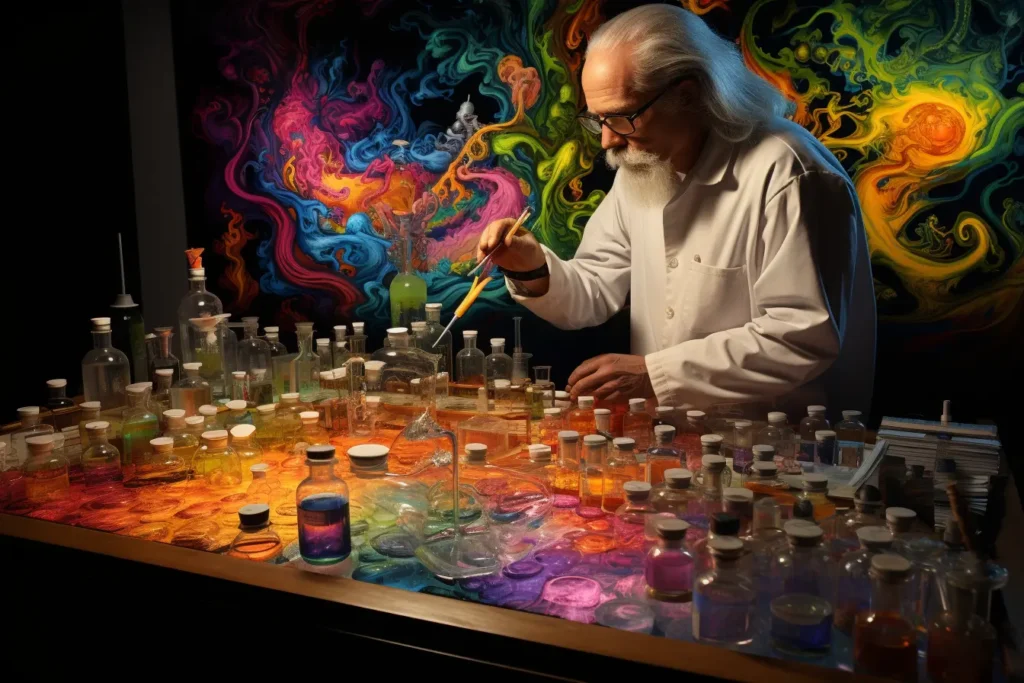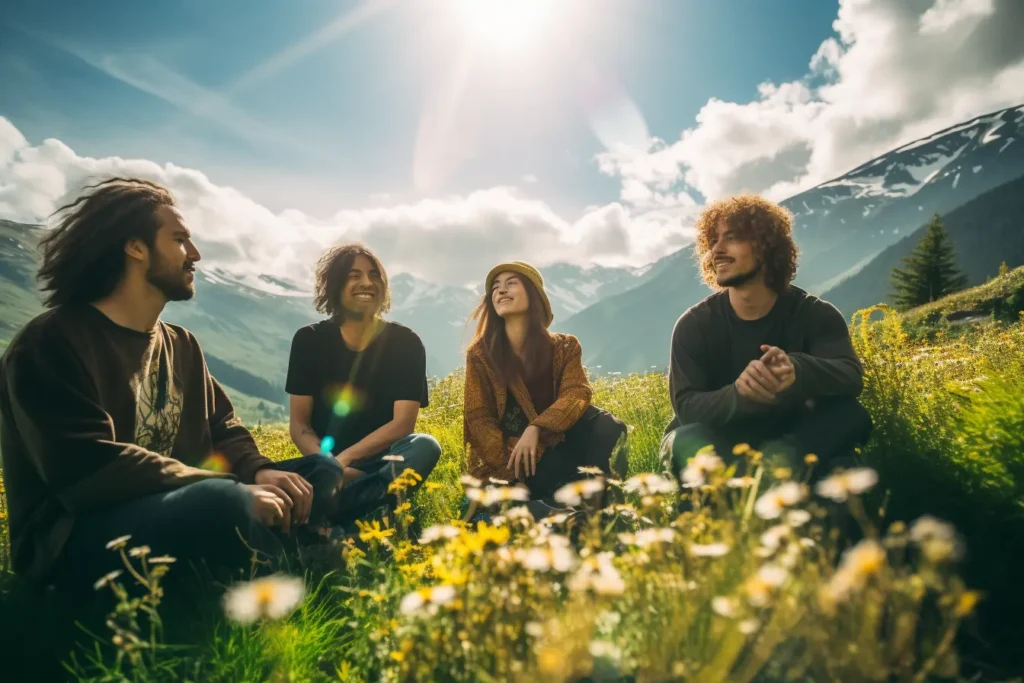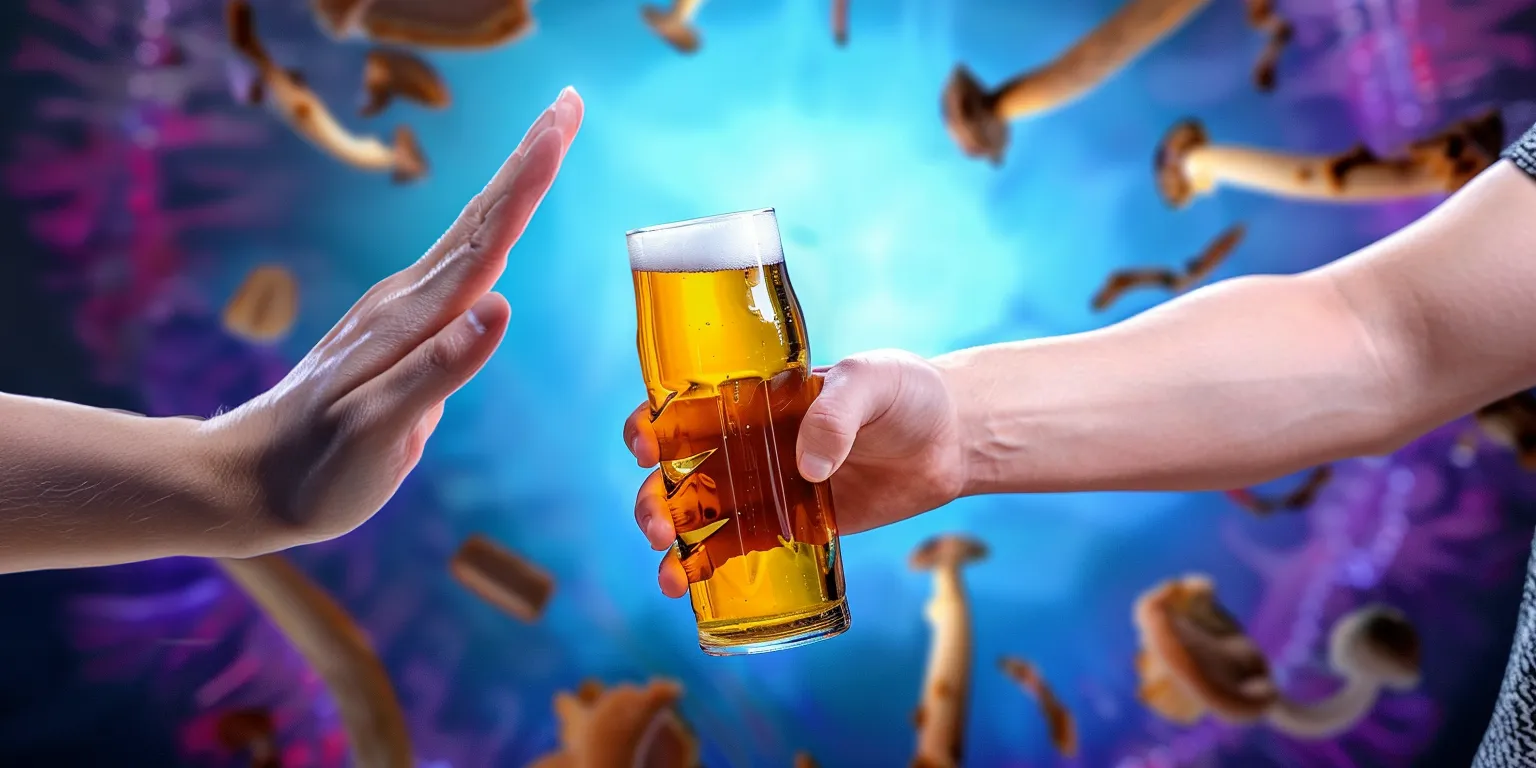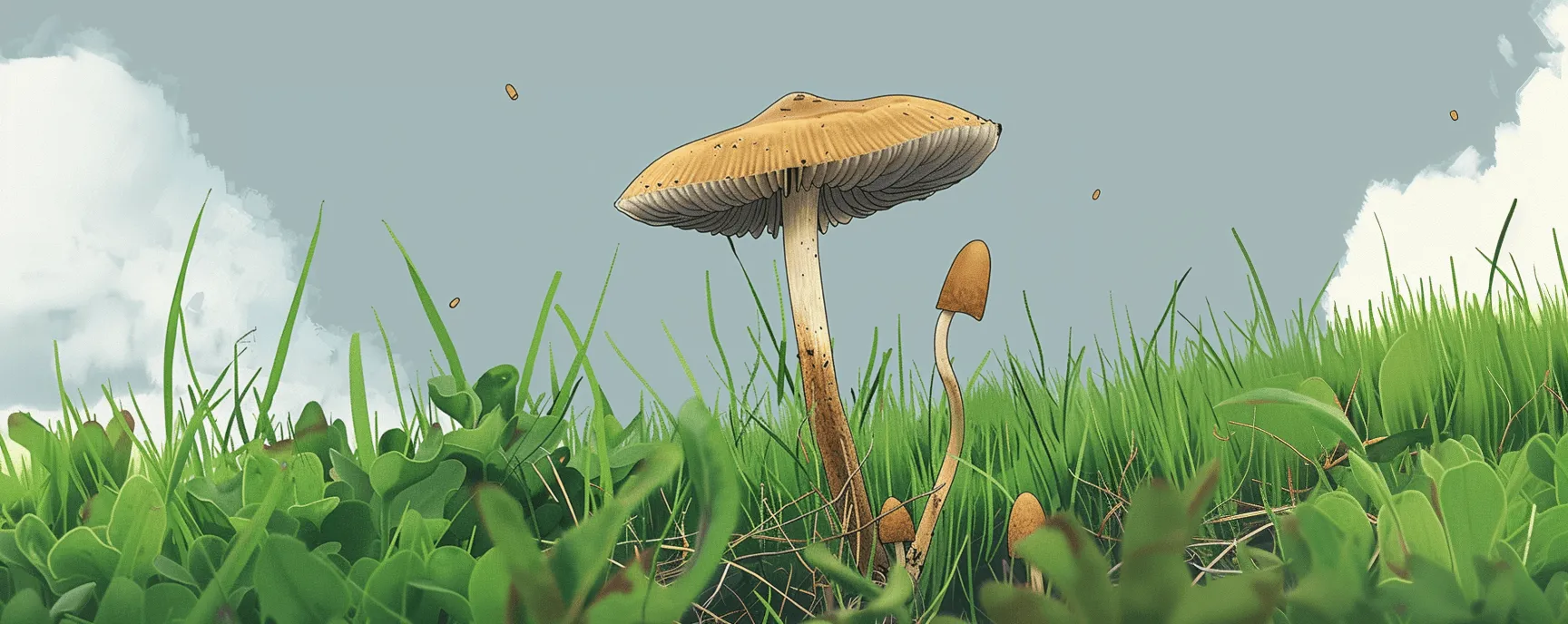When someone mentions psychedelics, you probably imagine brightly colored geometric shapes—summer days spent with friends hiking through ever-changing, shifting forests or the free-loving hippies of a bygone era. Maybe you associate the word with lab coat-wearing researchers hard at work developing new tools to help the nation battle myriad mental health disorders. Either way, you almost certainly have heard of them.

In the past ten years, psychedelics have gone from a taboo symbol of the era of counter-culture, free love, and the anti-war movement to heavily researched potential tools for various mental health conditions. Celebrities like Will Smith, Susan Sarandon, Jaden Smith, and Aaron Rodgers attribute personal growth and healing to the power of psychedelic experiences, often sharing their stories on social media where their words are retweeted, quoted, and spread across the globe.(1)
This surge of interest has propelled psychedelics out of the hazy underground of prohibition and into the limelight. Just this past June, the world’s largest ever psychedelic convention was hosted in Denver, Colorado, and it drew over ten thousand attendees.
All of this newfound interest in psychedelic drugs like DMT, LSD, psilocybin (aka magic mushrooms), and MDMA has been picked up by the average American, many of whom have never tried any sort of psychedelic.
How do you prepare for an experience as unique and potentially transcendent as an ayahuasca ceremony, an LSD trip, or your first time taking psilocybin?
The answer involves copious amounts of research, safety, personal responsibility, and understanding yourself and your goals. Here are five tips for your first psychedelic trip.
Tip One: Do Your Research

Psychedelics are one of the most intriguing families of psychoactive substances known to man. You’ve likely read about substances like MDMA being used to treat veterans with PTSD, or you may know someone who traveled to some far-off place to take ayahuasca and came back with astounding stories of self-transformation. That said, there is also the chance of a frightening or challenging experience. Someone may try LSD for the first time without reaching or understanding its effects and spend several hours having a “bad trip.” This doesn’t mean that will happen to you. Instead, it should serve as a word of caution and as a way to highlight the importance of research and informed self-exploration. Taking a cautious approach to your first psychedelic experience ensures not just a safer, but also a more constructive and meaningful journey.(2, 3)
Keep Up with Uncensored Psychedelic Trends
Join our newsletter at Psychedelics Uncensored.
We respect and protect your privacy. By subscribing your info will be subject to our privacy policy . Unsubscribe easily at any time
Explore a curated list of psychedelic podcasts here.
One of the first things that new psychonauts (and really all psychonauts) should understand is the unique pharmacological profile, effects, and potential risks and benefits of the compound they’re taking. For instance, while LSD and 2C-B may share some similarities in visual, auditory, and sensory effects, they have very different durations, interactions with other drugs, and potential side effects. Other substances often included in the psychedelic family include MDMA and ketamine, which have drastically different effects than traditional psychedelics. For example, MDMA is an entactogen, meaning it enhances empathy and has strong prosocial effects. In contrast, something like ketamine isn’t even technically psychedelic. Instead, it’s a dissociative anesthetic. Knowing the differences between a substance’s physical and subjective effects can make the difference between a smooth experience and one marked by adverse events and negative side effects.(4, 5, 6)
Learn more with our psychedelic compound guides:
Another important aspect to consider is the historical and cultural significance of a particular substance. For some, such as peyote and ayahuasca, this can be significant. Ayahuasca, for example, has been in use by various South American tribes for thousands of years. Its use is deeply steeped in mystical, cultural, religious, and ritual significance. The same can be said of peyote, something that is an important part of the religious experience for thousands of members of the Native American Church, and the use of which is protected by the First Amendment of the Constitution thanks to decades of legal battles led by Native Americans. Even psilocybin (magic mushrooms), one of, if not the most well-known psychedelic, is deeply rooted in the local medicinal and spiritual practices of Mesoamerican groups such as the Mazatec people. By appreciating and understanding these traditions, you can approach them with greater respect and reverence, potentially deepening their insights and connections.(3, 7)
Keep Up with Psychedelic Trends
Get uncensored psychedelic news, events, and updates. Join Psychedelics Uncensored!
We respect and protect your privacy. By subscribing your info will be subject to our privacy policy . Unsubscribe easily at any time
Being well-informed can also aid you with navigating and integrating the experience. Psychedelics can be intensely profound, and sometimes, the “you” of the post-experience is different from who you were beforehand. Psychedelics may bring up unresolved trauma, deep-seated fears, or new emotions. Having a strong foundation built upon a well-informed base of research can better equip you to process and understand things that you may encounter during your trip. This, in turn, can help you integrate those experiences into your daily life, ensuring meaningful, lasting changes and appreciation of the psychedelic experience. Essentially, reading and researching your chosen psychedelic is not just a good safety practice, it’s a commitment to a holistic, transformative journey.
Tip Two: Know Your Dose

One of the most important parts of a psychedelic experience is dosing. Each psychedelic has unique and often wildly different doses. Doses determine the intensity and duration of a psychedelic trip and the potential risks and benefits associated with the substance.
It should also be noted that the dose-response relationship is not always linear. Meaning a small increase or decrease in dose can lead to significant changes in the subjective psychedelic experience. This could be the difference between a pleasantly mild trip, and complete ego dissolution. For those seeking therapeutic benefits, finding your “sweet spot” is essential to your first trip. Too low a dose may not produce the sort of effects you’re looking for, while too strong a dose could lead to unexpected or adverse psychedelic experiences. Higher doses can also increase your likelihood of experiencing negative side effects like paranoia, anxiety, and physical side effects like nausea. By understanding the best dose for you, you can optimize your first psychedelic trip, ensuring that it’s safe and fruitful.
When determining the correct dose, you should take into account a variety of factors. Body weight, metabolism, psychological state, when you last ate, and how much sleep you’ve had can all affect the subjective psychedelic experience. You should also consider the drug itself. LSD is measured in micrograms, and 2C-B in milligrams, requiring only minute doses to achieve astounding effects. In contrast, a psychedelic like psilocybin is typically measured in grams. Another crucial factor is the method of delivery. Are you taking something orally, smoking it, or inhaling a vapor? All of these can impact the effects of the drug, sometimes dramatically altering your experience.
Generally speaking, you should always start with a lower dose of whatever substance you’re taking. This will help you gauge your sensitivity and response to the drug. As they say, “you can always take more, but you can’t take less.” Once the psychedelic train has left the station, you’re along for the ride.
Learn more about dosing: 10 Tips for a Safe Psychedelic Trip
Tip Three: Know Yourself

Navigating something as inherently unpredictable as a psychedelic trip requires more than just knowledge about the substance or the dose. It requires a deep understanding of yourself. Self-awareness, or the intimate knowledge of your strengths, vulnerabilities, and boundaries, can serve as a framework for building out the rest of your psychedelic scaffolding. Most importantly, knowing your limitations can be an important key to encouraging a transformative and positive experience vs. something that negatively impacts you.
Psychedelics can amplify things like empathy, connectedness with the world, feelings for friends, family, and loved ones, or evening deepening your connection to spiritual ideals. However, they can also bring other, darker aspects of the psyche to the surface. If you have unresolved trauma, a history of mental illness, or are simply going into the experience feeling unsure, psychedelics may amplify those feelings.
They also have the potential to aggravate some conditions like schizophrenia and are not recommended with people with certain psychological histories.(8)
Other psychedelic contraindications include:
- Cardiovascular issues: Some psychedelics can increase heart rate and blood pressure.(8)
- Pregnancy and breastfeeding: The effects of psychedelics on fetal development and nursing infants are not well-studied.(8)
- Medication interactions: Many psychedelics can interact with medications, including SSRIs, MAOIs, and certain antipsychotics.(8)
- Personal or family history of psychosis: Individuals with a history of psychotic disorders or a family history might be at a higher risk of experiencing adverse psychiatric reactions.(8)
- Severe anxiety or panic disorders: Psychedelics can intensify feelings of anxiety or induce panic attacks.
- Bipolar disorder: There is a potential for psychedelics to trigger manic episodes.(8)
Understanding your personal history and the potential risks that psychedelics could hold for you is an important part of preparing for your journey.
If you have a keen sense of yourself, you may be able to approach any new revelations with a sense of preparedness and surety. If, for example, you are seeking to resolve a past negative event through the mindful use of psychedelics, then having a solid understanding of your emotional and mental triggers could help you know when to push forward with a psychedelic experience or when to pull back.
Tip Four: Understand Your Set, Setting, and Intention

In the intricate dance of psychedelic exploration, three elements often emerge as paramount in determining the nature and outcome of the experience: set, setting, and intention. These components refer to the internal mindset, the external environment, and the purpose behind the journey, respectively. Their collective importance is profound, as they collaboratively shape the trajectory of the psychedelic voyage, influencing its therapeutic potential and the associated risks.
“Set” refers to your mindset before embarking on the psychedelic experience. This encompasses your current emotional state, mental health, and overall psychological preparedness. An individual dealing with anxiety or unresolved traumas might face intense emotional challenges during the experience. However, a clear and stable mindset can act as a solid foundation, allowing for deeper exploration and understanding.
“Setting” pertains to the physical and social environment in which your psychedelic journey unfolds. This includes the location, comfort level, the presence (or absence) of other people, and the overall ambiance. A serene and safe environment (and potentially a familiar one) can provide the necessary grounding, enabling the individual to delve into the experience without apprehension. The presence of a trusted companion or a trained guide can further enhance the safety and depth of the journey, ensuring that any challenges are successfully navigated.
“Intention” stands as the guiding star of your psychedelic voyage. It signifies the purpose or goal behind embarking on such a journey. Whether seeking healing, personal growth, or spiritual connection, a clearly defined intention can act as your compass, providing direction and meaning to the experience. It offers a framework within which the revelations and insights gained can be integrated into your life.
In essence, set, setting, and intention form a foundation upon which the psychedelic experience can be constructed. They act as guiding principles, ensuring that the profound nature of these substances is approached with the reverence and mindfulness they deserve.
Tip Five: Know How to Integrate Your Psychedelic Trip

Your psychedelic trip, whether smooth sailing, deeply profound, mystical, transformative, or harsh and difficult is only the beginning of a larger journey. While psychedelics can offer you deep insights, incredible visual experiences, or catharsis, the true value lies in what you do after the effects have faded away. This is the process known as integration. Integration is the deliberate reflection upon, understanding, and implementation of the lessons learned from the psychedelic journey. It’s a crucial step in ensuring that the things you learned about yourself during the subjective effects of psychedelics become more than just a memory.(9)
Integration bridges the often abstract, symbolic, or intense experiences encountered during a psychedelic journey and the practicalities of everyday life. Without this bridge, the profound insights gained can become lost in the shuffle of daily routines. By actively engaging in integration, individuals can dissect their experiences, discerning the lessons and messages, and then find ways to apply them. This might involve journaling, discussing the experience with trusted friends or therapists, or even adopting new practices or habits that align with the newfound insights.(8)
Moreover, the integration process provides a safety net for those who might have encountered challenging or distressing experiences during their journey. However, with the right support and reflection, these challenging experiences can be transformed into opportunities for healing and growth. In essence, integration ensures that the psychedelic experience, whether blissful or challenging, is honored, understood, and utilized for personal growth and understanding of your deeper self.
Psychedelics offer us voyages of discovery and portals into the inner depths of our psyches. They offer us the hope of healing, better understanding of ourselves, and our place in the cosmos. But like any other journey, you need the tools to thrive in the psychedelic experience. From understanding the substances and their effects to recognizing your own mental and emotional landscape, every step in preparation can profoundly influence the outcome.
As you stand on the precipice of your journey, arm yourself with knowledge, introspection, and intention. By respecting yourself and the power of the psychedelics you’re about to take, you open the door to a world of mystery, learning, and, hopefully, healing. The path lies before you, ready to carry you off on this grand adventure into the self and, if you’re ready, into worlds beyond.
Safe travels.
Sources

1. Gregorio, D. D., Aguilar-Valles, A., Preller, K. H., Heifets, B. D., Hibicke, M., Mitchell, J., & Gobbi, G. (2021). Hallucinogens in Mental Health: Preclinical and Clinical Studies on LSD, Psilocybin, MDMA, and Ketamine. Journal of Neuroscience, 41(5), 891–900. https://doi.org/10.1523/JNEUROSCI.1659-20.2020
2. Mitchell, J. M., Bogenschutz, M., Lilienstein, A., Harrison, C., Kleiman, S., Parker-Guilbert, K., Ot’alora G., M., Garas, W., Paleos, C., Gorman, I., Nicholas, C., Mithoefer, M., Carlin, S., Poulter, B., Mithoefer, A., Quevedo, S., Wells, G., Klaire, S. S., van der Kolk, B., & Tzarfaty, K. (2021). MDMA-assisted therapy for severe PTSD: a randomized, double-blind, placebo-controlled phase 3 study. Nature Medicine, 27(6), 1025–1033. https://doi.org/10.1038/s41591-021-01336-3
3. Malcolm, B. J., & Lee, K. C. (2017). Ayahuasca: An ancient sacrament for treatment of contemporary psychiatric illness? Mental Health Clinician, 7(1), 39–45. https://doi.org/10.9740/mhc.2017.01.039
4. Stein, C. A., Penn, A., Van Hope, S., Dorsen, C. G., & Mangini, M. (2022). The Pharmacology and Clinical Applications of Psychedelic Medicines Within Midwifery Practice. Journal of Midwifery & Women’s Health. https://doi.org/10.1111/jmwh.13371
5. Schmid, Y., Enzler, F., Gasser, P., Grouzmann, E., Preller, K. H., Vollenweider, F. X., Brenneisen, R., Müller, F., Borgwardt, S., & Liechti, M. E. (2015). Acute Effects of Lysergic Acid Diethylamide in Healthy Subjects. Biological Psychiatry, 78(8), 544–553. https://doi.org/10.1016/j.biopsych.2014.11.015
6. Papaseit, E., Farré, M., Pérez-Mañá, C., Torrens, M., Ventura, M., Pujadas, M., de la Torre, R., & González, D. (2018). Acute Pharmacological Effects of 2C-B in Humans: An Observational Study. Frontiers in Pharmacology, 9. https://doi.org/10.3389/fphar.2018.00206
7. Mazatec Shamanic Knowledge and Psilocybin Mushrooms. (2022, February 10). Chacruna. https://chacruna.net/mazatec-shamanism-and-psilocybin-mushrooms/
8. Medical Contraindications to “Classic” Psychedelic Use. (n.d.). Psychedelics.ucsf.edu. https://psychedelics.ucsf.edu/blog/medical-contraindications-to-classic-psychedelic-use
9. Gorman, I., Nielson, E. M., Molinar, A., Cassidy, K., & Sabbagh, J. (2021). Psychedelic Harm Reduction and Integration: A Transtheoretical Model for Clinical Practice. Frontiers in Psychology, 12. https://doi.org/10.3389/fpsyg.2021.645246
This material is not intended as a replacement or substitute for any legal or medical advice. Always consult a medical professional about your health needs. Psychedelics are widely illegal in the United States, and readers should always be informed about local, state, and federal regulations regarding psychedelics or other drugs.

 David Connell
David Connell

